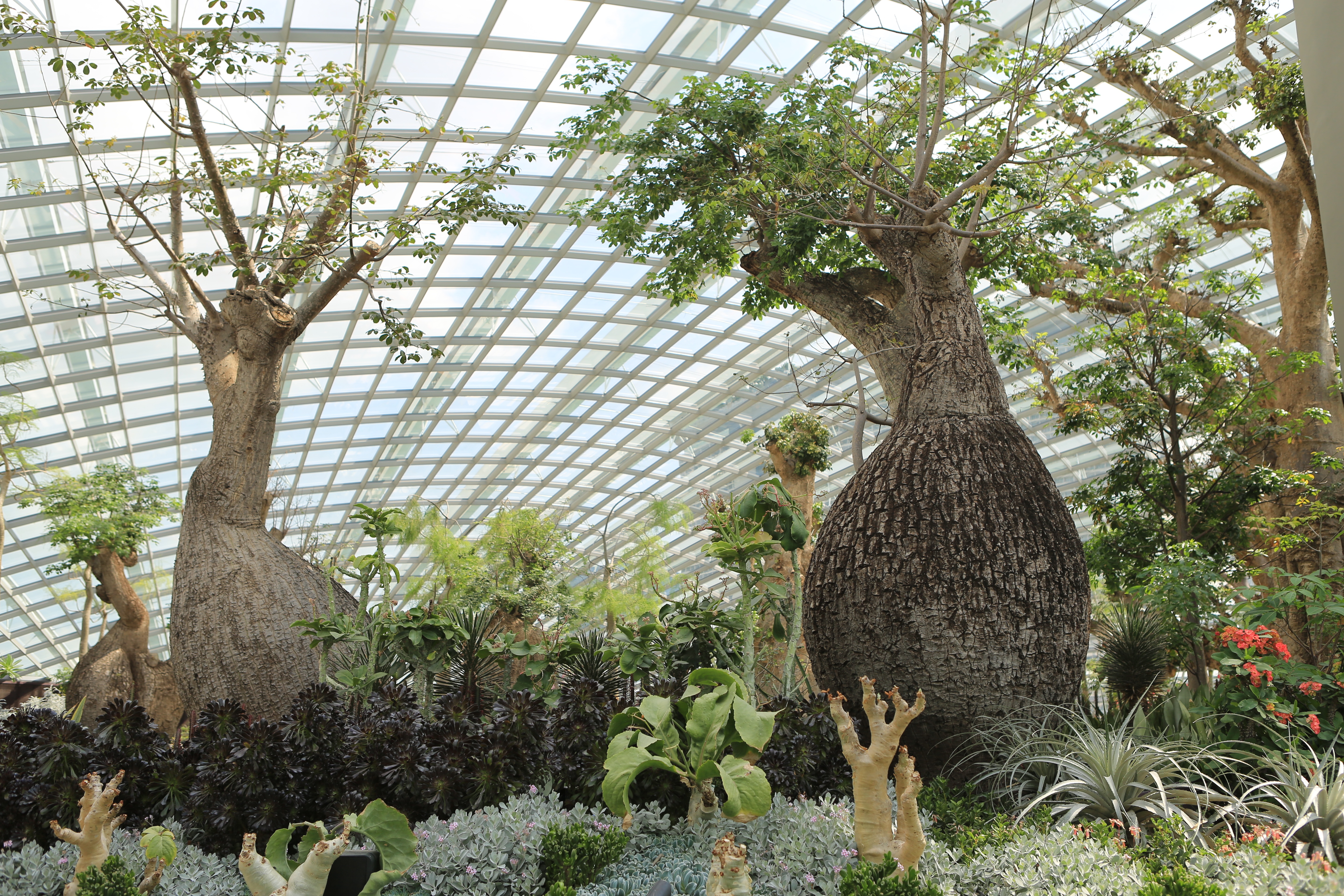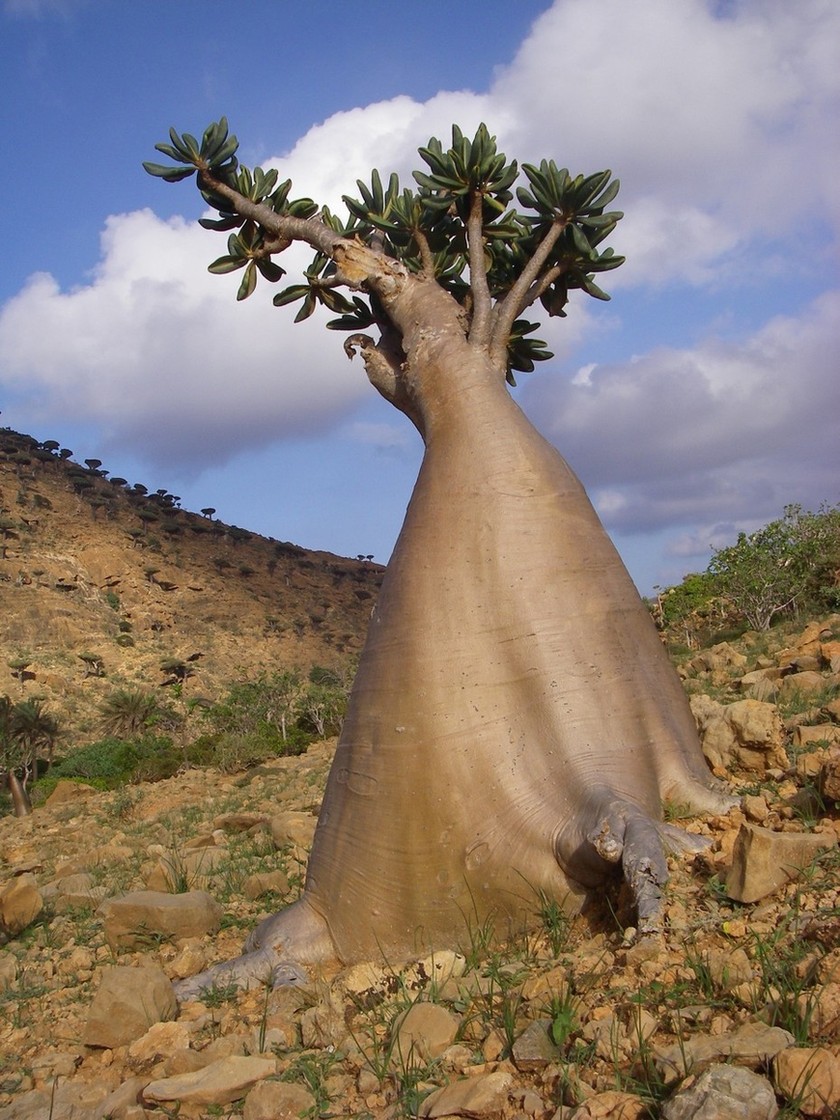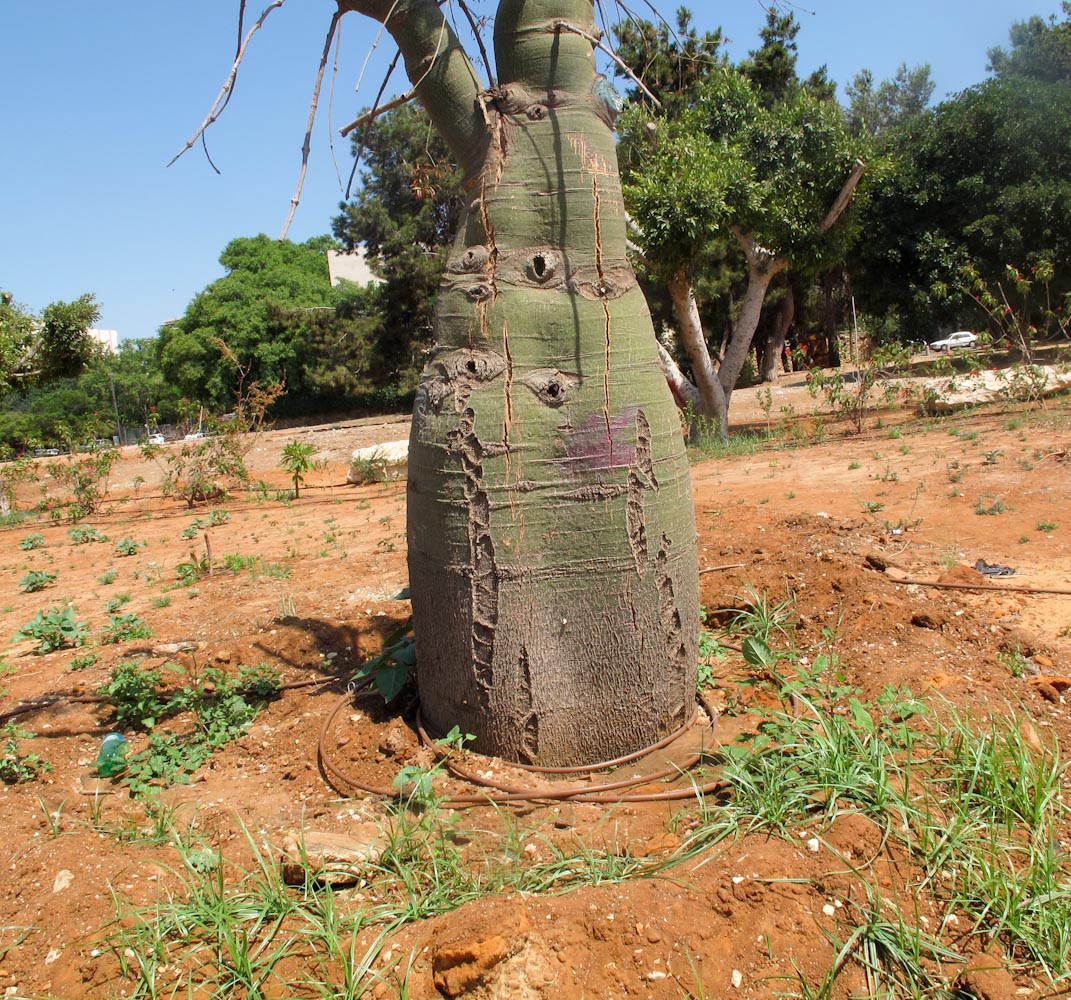ต้นไม้ทรงขวด

It is worth noting that the saying: "Without work does not pull the fish out of the pond," works here. So, to get tasty tree nuts (seeds) have to work considerably. The fact that the seeds are in the pods of which the skin is thick. In addition to this, each top seed has stubble. It is because of this bristle kind of tunic, a tree and was named - brahihiton. Seed collection is carried out only with gloves, as the bristles causes itching.
The seeds grow in pods, the length of which reaches 10 centimeters. The pods are very impressive look on the tree through the purple hue. It is from these pods in the form of boats and take out the seeds, which are covered with hairs on the outside bright yellow.

Bottle tree leaves juicy dark-green color. As regards their form, on one and the same tree the leaves it may be different. The thing at the age of foliage. So you can see how simple oval leaves are combined with leaves that have three to five lobes. It maybe quite old trees.
Flowers bottle tree shaped like bells. They are small diameter of each bell about 1.5 cm. Flowers are clustered in umbels, and therefore produce a memorable experience. Bells may be a different color: greenish, cream or white. Inside bells speckles completely covered in different shades.

Well, if you look into the wilds of our domain, it is possible there's something else to say.
Like many other attributes of human existence, live ornamental plants, including succulents, also subject to the influence of fashion, which usually comes to us from the West, with the exception, perhaps, the art of miniature bonsai and rock gardens. And in this case, both art emerged in the East, first conquered the West, endured there adaptive phase of development according to the European mentality, and from there, that is, from the West, slowly gaining their fans in the former Soviet Union. However, in recent years, in this case there is a significant impact and the East, especially noticeable in the eastern regions of Russia.
And although the fashion for different groups of succulents are not so pronounced and fleeting, as, for example, women's clothing, yet a number of trends can be traced quite clearly. So, the West has long endured decades cactus boom Change shorter (about a decade) period fashion "living stones." The last 25-30 years can be called the era of bottle trees or kauditsiform. This is evidenced by the numerous clubs for these plants, as well as sales, as seeds and live plants, many specialized firms of the West. (Probably still dragging other types of plants - mezembami, Crassula, "bottles" - not replace cactuses, and arise and develop in parallel with them, that is. F. Process is not sequentially and in parallel - Ed.) It should be noted that the first bottle trees (from Africa - Ed.) in European collections appeared decades earlier discovery of America and the establishment of the first collections of cacti. In the botanical garden of the University of Kiel (Germany), there are species of the genus Cyphostemma, which nearly 550 years.

The term "kauditsiforma" (from the Latin caudex - stem, stump) invited Dr. Gordon Rowley (O. KO 1eu ^) to indicate succulents vodozapasayuschim main body of which is the so-called hypocotyl or podsemyadolnoe knee - part of the shoot (stem), located between root and seed leaves or leaf (monocots). There is still the term "pahikaulnye (i.e. tolstostebelnye) plants" which indicates succulents vodozapasayuschuyu function which performs this stem, and photosynthetic - leaves tend nesukkulentnye partially or fully deciduous in the dry season. For example, Pachypodium brevicaule, Adenium repanda, Euphorbia trichadenia - typical kauditsiformy and Pachypodium lamerei, Adenia keramenthus, Euphorbia bupleurifolia - typical pahikaulnye plants. However, not always possible to draw a difference between the two is even entering the quantitative characteristics (for example, the ratio of mass and volume of the stem to the caudex), since much depends on the growth conditions (culture) and plant age. Therefore, the two terms are often used interchangeably.
Furthermore, many kauditsiform and pahikaulnyh plant culture function caudex stem and operate thickened roots, tubers, bulbs and the like, usually underground organs, especially elevated when landing on the surface of the soil. And finally, many succulents, especially leafy, may be formed as a kauditsiform or pahikaulnyh plants appropriate pruning. All this variety somewhat conventionally referred to as bottle trees. Conventionality of this is the fact that not all species are trees, and their shape is often not "bottle" (the term itself is familiar to many from school courses botany and geography, and is associated with the sun-baked African savanna with separate baobabs) .

Given all the above, it is difficult, at least approximately, indicate the total number of species of bottle trees. However, even under the most strict, the approach we have collected at least 1000 - the amount that can satisfy anyone, even the most "greedy" collector.
It should be borne in mind that the bottle trees - category is not systematic, and morphologically physical, or if you prefer, "physiognomic". That is - perceived visually, so these plants are found in many botanical families. So, kauditsiformami pahikaulnymi and are all members of the family Apocynaceae succulent (Apocynaceae); Bombaksovyh (Bombacaceae); Strastotsvetnyh (Passifloraceae); Cucurbits (Cucurbitaceae), except for the genus Xerosicyos; Geranium (Geraniaceae); in each of which there are more than a dozen species. This includes but not many representatives of succulent families Burzerovyh (Burseraceae), Anakardievyh (Anacardiaceae), Fukerievyh (Fouqueriaceae), Ikatsionovyh (Icacinaceae), mulberry (Moraseae) and others. Moreover, a bottle trees belong in full taxa birth: Brachystelma, Fockea, Raphionacme of Asclepiadaceae (Asclepiadaceae), Cyphostemma grape (Vitaceae), Jatropha from Euphorbiaceae (Euphorbiaceae), and the fact of euphorbias (Euphorbia) there are many kauditsiform. There are several types of 'bottles, "and of such common houseplants as balsam (Impatiens) and begonia (Begonia). On the other hand, few kauditsiform appreciate this succulent family as Crassulaceae (Crassulaceae) - a genus Tylecodon; practically no them, except tolstokornevyh Trichodiadema, Delosperma, Nananthus etc.. claim. among Mezembriantemovyh (Mesembryanthemaceae) and Cactus (Cactaceae). Few typical bottle trees and the class of monocots (Monocotyledonis) plants - Nolina, Beaucarnea, Calibanus, Testudinaria, but it is to include all monocot bulbous and klubnelukovichnye that provided high landing are quite "kauditsiformichesky" view, moreover, many of them beautifully in bloom.

Variety appearance bottle tree is very large. Here and miniature, and not reaching 10 centimeters and some Tylecodon Othonna, and huge 60-meter Ceiva pentandra, and reaching up to three meters in diameter squat Trematosperma cordatum, in the period of rest is more like fragments of rock or giant termite mounds, than live plants. Stems "bottles" can be more or less smooth, spiny (most Pachypodium), indented with deep cracks (Testudinaria) or that is especially prized by collectors, decorated like scales, leaf pads, so-called Present. These are some of the representatives of Euphorbia, Othonna, Tylecodon.
About flowers bottle trees because of their large systematic diversity is difficult to tell in brief. Among them are species with small, inconspicuous yellow-green flowers (most Cucurbitaceae) and with comparatively large bright, for example, Apocynaceae. And if for some skilled care "bottle" (Ipomea, Adenuim, separate Pachypodium et al.) Begin to bloom with 3-4 years of age, then to achieve flowering in the home, such as baobab (even the most minor of them - Adansonia fony) almost impossible. In general, we can say that for collectors of these plants flowering is not an end in itself, but of course, no one will mind if any species yet to bloom.

In natural habitats, many bottle trees, especially large species prefer moist enough landscapes - savannas, woodlands, and so on. D. Small species are often found in more arid areas. Dry season them, as a rule, makes the ability to move partially or fully retracted into the soil. For this reason, many of them can tolerate small freezer, but in general the typical pahikaulnyh plants almost no truly hardy species.
Richest bottle trees Africa, especially South and East, including close to it floristic south-western part of the Arabian Peninsula and the small nearby islands. Followed by Mexico and the United States, followed by South America, the rest of Asia, and finally, which is especially a shame - Australia, most of which occupy arid (dry) areas. Particularly noteworthy is the island of Madagascar - a real natural reserve bottle trees. Suffice it to say that there grows a large portion of the known species of baobab and pahipodiumov has its original members of the genera Adenia, Cussonia, Cyphostemma, Moringa. In addition, on the island grow nowhere else but in Alluaudia, Alluadiopsis, Delonix and others.
Culture bottle trees in general (except for watering) is similar to that for other succulents, but because of the wide variety of environmental conditions, natural habitats, has a number of features, some of which are discussed below.

The best, and often the only method of reproduction * Most of these plants is seeding. It should take into account the annual cycle of development of individual species. This factor is particularly important for all Tulesodon, Sarsosaulon, deciduous and Othonna Relargonium that in our conditions in the summer in a state of rest. The seeds of these species is best to sow in the period from August to February, otherwise it can be difficult (especially members of the genus Tulesodon who have small seeds).
The period of growth all these plants is necessary to ensure the highest possible natural light, and in the more northern areas, where the length of the day is not more than 6-7 hours - artificial supplementary lighting, especially with the onset of cloudy weather. Even at first seedlings of these species do not require high humidity, so there is no need for the equipment and for the period teplichku bowl germination of seeds is enough to cover a suitable size glass jar or other transparent utensils When sowing should also take into account the fact that some pahikaulnye plants ( Adansonia, Suphostemma, Jatropha, etc..) have a fairly large seeds that before sowing is recommended to soak for a day in a pale pink solution of potassium permanganate, with viable seeds immediately or after some time seeds sink to the bottom, which after 24 hours left to float on surface of the solution, it is better not to plant (or sow separately) - they are unlikely to germinate, but can be a source of various infections. Large seeds are buried to a depth approximately equal to their size. To avoid eating sprouting seeds larvae fungus gnats and other pests, the soil surface must be sprinkled with a solution of an insecticide, periodically repeating this procedure, if the seeds sprout a long time (which is very typical for Surhostemma). Sowing should get full coverage, especially for species that have large seeds. Otherwise, the seedlings are greatly elongated, which subsequently affects their decorative - often the lower part of the stem is much thinner than the top, who grew up on the "normal" world.

Standard succulents zemlesmes (equal parts of humus and coarse sand) suitable for the vast majority of bottle trees. The only exceptions are growing in the nature of epiphytic Hydnophytum and Mirmecodia in zemlesmes for which it is desirable to add 20-30% peat moss or leaf land. A similar mixture is better to use for planting, especially small seeds.
When cultured home pahikaulnyh tall plants growing in the first place (Adansonia, Seiba, Chorisia, et al.), It is necessary to resort to pruning. This operation is best carried out in the first half of the growing season to make up "drought" had time to ripen new growth. If you plan to cut more than a third of the crown, pruning is desirable to coincide with the transplant and thus undercut the roots of plants to avoid a sharp imbalance between underground and aboveground parts, often leading to the death of the plant. In a culture often resort to cutting those which gave the winding crown (most of the Cucurbitaceae, Iromoea, Dioscorea, etc.). Thus it is necessary to leave a small portion of the winding escape with a few leaves, as many times during the growing season truncation "on the stump" (caudex) leads to severe depletion of the latter and, as a consequence, to the death of the whole plant. Quite impossible to cut such kauditsiformy, if the objective of their flowering and fruiting. During pruning you need to ensure that the cut above accounted cotyledons or the place where they were (in older specimens), since not all species are able to sprout below this point. Cut parts of the plant can be used for grafting, but even different treatment biodynes does not always lead to success.

Transplant bottle trees is best done at the beginning of the growing season, rather than at the end of the rest period (such as cacti). The difference is that the "bottle" for 1-2 weeks before transplanting be poured, and then transplanted with all directed in such instances precautions. This is especially important for plants severely shrunken usually hibernated at elevated temperature.
The vast majority of bottle trees does not apply to supersukkulentam, so during the growing season they need regular watering sufficiently abundant, winter dormancy and should not delay more than 5 months, especially for young plants. Temperature of 10-15 ° C at the time suit most species. If you can not provide such conditions, plants have to be watered from time to time, and winter growth in spring can be cut off if it spoils the appearance. Many of the "bottle" in a rest period is not demanding to light and can be successfully hibernate deep in the cool room.

Various bulbs and other geophytes better cultured in flat pots - 1-3 cm in height, depending on the size of the bulb, because otherwise contractility (retracting) the ability of the roots of the bulb within the first growing season will disappear in the soil. Most of these plants successfully plant grows and blooms with such unnatural for them landing, furthermore, often the bulbs during the growing season due to surface scales are painted in different colors, or acquire an interesting pattern. In addition, other conditions being equal, primarily light, highly planted bulb throws shorter leaves, which generally has a positive effect on the general form of the plant. However, this method of cultivation is necessary to remember that many potentially hardy geophytes lose their hardiness and may die even at -3 ° C overnight, and it is better to avoid lowering the temperature below 0 ° C.
When culturing bottle trees need to be aware of this unpleasant feature, as the toxicity of some of them. К таковым, в первую очередь, относится подавляющее большинство Молочайных, особенно представители рода Synadenium, а также Adenium, Туlесodon и др. При работе с этими растениями, особенно при обрезке, необходима осторожность, иначе попадание сока в кровь или на слизистые оболочки тела может вызвать серьезное отравление. По этой же причине следует исключить контакт с такими растениями детей, а также домашних животных и птиц. И хотя то, что ядовито для человека, может оказаться совершенно безвредным или даже полезным для животных и особенно для птиц, вряд ли стоит экспериментировать на эту тему.

Некоторые каудициформы и пахикаульные принадлежат к редким и исчезающим в природе видам (Dendrosicyos socotrana, Pachycormis discolor, отдельные Pachypodium и др.) и включены в Красную Книгу Международного Союза Охраны Природы (МСОП). Сбор этих растений в естественных местообитаниях запрещен или жестко ограничен, а культивирование или размножение их в неволе должно только приветствоваться, так как позволяет сохранить и приумножить генофонд этих видов (правда, не всегда полноценный, но все же это лучше, чем не иметь никакого).
Многие бутылочные деревья благодаря своим причудливым силуэтам могут служить прекрасным украшением хорошо освещенных помещений, мелкие виды пригодны для создания различных композиций, немало видов этих растений являются благодарным материалом для любителей бонсай, большинство луковичных в цветущем состоянии подойдут в качестве отличного подарка вместо обычных срезанных цветов.


Остров Сокотра — это загадочный мир. Остров мифов и легенд. Его древнее название переводится с санскрита как «земля блаженства». Расположен остров в 250 км от Африки и в 350 км от Аравийского полуострова.
Остров уникален своей флорой и фауной. Большинство видов растений и животных — эндемики, т.е. больше нигде в мире не встречаются. И это единственное место на Земле, где растут уникальные бутылочные деревья .

Such Bottle trees - one of the symbols of the island of Socotra, as считаются эндемиками, т.е. растущими только в этом месте Земли.

Свою форму деревья приобрели в связи с засушливым местным климатом и дефицитом влаги. Толстый ствол и мясистые листья, позволяют дольше сохранять жидкость.

Обладая мощной корневой системой, деревья прорастают среди камней и расщелин:
В феврале у деревьев начинается период цветения. На ветках появляются розовые цветки, а кора приобретает бронзовый оттенок.

Бутылочные деревья растут в низине, ближе к океану:
Сокотрийцы очень гордятся этими деревьями,постоянно указывая что это Эндемик:

Хотя, надо заметить, что это только отчасти правда. Бутылочные деревья есть и в других странах, например, в Австралии, но на Сокотре растет уникальная разновидность этого дерева.













Ну а вот бывают еще и такие бутылочные деревья :-)

sources
http://www.succulent.com.ua
http://www.sad-sm.ru
http://www.succulent.com.ua
http://www.sad-sm.ru
- Post a new comment
- 7 comments
Спасибо.Очень интересно.
на здоровье .. посмотрите по ссылке в начале поста еще интересные деревца :-)
ВИДЕТЬ НА ФОТО ВИДЕЛА..ДАЖЕ В ЖУРНАЛЕ БЫЛО..НО ПОДРОБНОСТИ НЕ ЗНАЛА...СПАСИБО.))
теперь будем знать больше :-)
Интересно)Мне одному стволы напомнили по форме мяч для американского футбола?
Ваша запись появилась в рейтинге 3000-ТОП. Отслеживать судьбу записи вы можете по этой ссылке.
Подписаться на рассылку или отказаться от рассылки можно здесь.
Подписаться на рассылку или отказаться от рассылки можно здесь.
- Post a new comment
- 7 comments



No comments:
Post a Comment